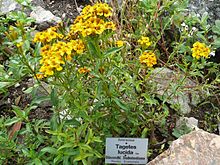- Tagetes lucida
-
Tagetes lucida Scientific classification Kingdom: Plantae (unranked): Angiosperms (unranked): Eudicots (unranked): Asterids Order: Asterales Family: Asteraceae Genus: Tagetes Species: T. lucida Binomial name Tagetes lucida
Cav.[1]Tagetes lucida is a half-hardy sub-shrub native to Mexico and Central America. It is eaten as an herb and is commonly used as a substitute for tarragon. The leaves have a tarragon-like flavor, with hints of anise. Common names include Mexican marigold, pericón, Mexican mint marigold, Mexican tarragon, Spanish tarragon, and Texas tarragon.
Contents
Description
Mexican tarragon grows 18-30 in (46-76 cm) tall. The plant is bushy with many smooth, upright, unbranched stems. The leaves are linear to oblong, about 3 in (7.6 cm) long, and shiny medium green, not blue-green as in French tarragon (Artemisia dracunculus var. sativa). In late summer it bears clusters of small yellow flower heads on the ends of the stems. The flower heads are about 0.5 in (1.3 cm) across and have 3-5 golden-yellow ray florets.[2] The flowers are hermaphroditic (have both male and female organs) and are pollinated by insects.[3]
Uses
Dried leaves are ground into a powder then used as a tarragon substitute for flavoring soups, sauces etc. A pleasant anise-flavored tea, popular in Latin America, is brewed using the dried leaves and flowering tops. The petals are used as a condiment.
A yellow dye can be obtained from the flowers.[3]
The dried plant is burnt as an incense and to repel insects.
Tagetes lucida was used by the Aztecs in their ritual incense known as yyauhtl.[4] It is also used by the Huichol, mixed with Nicotiana rustica (a potent wild tobacco), for its claimed psychotropic effects.[5][6]
In one study, methanolic extract from the flower inhibited growth of Staphylococcus aureus, E. coli, and Candida albicans cultures-an effect that was enhanced with exposure to ultraviolet light. The roots, stems, and leaves also had the same effect when irradiated with UV light.[7]
Phytochemistry
The plant contains the following compounds:
Notes
- ^ "Taxon: Tagetes lucida Cav.". Germplasm Resources Information Network. United States Department of Agriculture. 2011-05-31. http://www.ars-grin.gov/cgi-bin/npgs/html/taxon.pl?36200. Retrieved 2011-10-09.
- ^ Christman, Steve (2004-02-27). "#614 Tagetes lucida". Floridata. http://www.floridata.com/ref/t/tage_luc.cfm.
- ^ a b "Tagetes lucida - Cav.". Plants For A Future. http://www.pfaf.org/user/Plant.aspx?LatinName=Tagetes+lucida.
- ^ "Tagetes lucida - Marigolds- Americas to Argentina". Entheology. http://www.entheology.org/edoto/anmviewer.asp?a=279. Retrieved 2008-08-30.
- ^ a b c Okun, Ronald (1977). Pharmacology & Toxicology Annual Review. Annual Reviews, Incorporated. pp. 656. ISBN 9780824304171.
- ^ Schultes, Richard Evans; Siri von Reis (1995). Ethnobotany: evolution of a discipline. Timber Press. pp. 382. ISBN 9780931146282.
- ^ Nader, Laura (1996). Naked Science: Anthropological Inquiry Into Boundaries, Power, and Knowledge. Routledge. pp. 61. ISBN 9780415914659.
- ^ a b c Bicchi, Carlo; et. al. (1998-12-04). "Constituents of Tagetes lucida Cav. ssp. lucida Essential Oil". Flavour and Fragrance Journal (John Wiley & Sons, Ltd.) 12 (1): 47–52. doi:10.1002/(SICI)1099-1026(199701)12:1<47::AID-FFJ610>3.0.CO;2-7.
- ^ Cicció JF (December 2004). "A source of almost pure methyl chavicol: volatile oil from the aerial parts of Tagetes lucida (Asteraceae) cultivated in Costa Rica". Rev. Biol. Trop. 52 (4): 853–7. PMID 17354394.
- ^ Bohm, Bruce A.; Tod F. Stuessy (2007). Flavonoids of the sunflower family (Asteraceae). Springer. pp. 597. ISBN 9783211834794.
Categories:- Tageteae
- Plants described in 1796
- Flora of Mexico
- Flora of Central America
- Agriculture in Mesoamerica
- Butterfly food plants
- Crops originating from Mexico
- Flowers
- Garden plants of North America
- Drought-tolerant plants
- Asteraceae stubs
Wikimedia Foundation. 2010.

